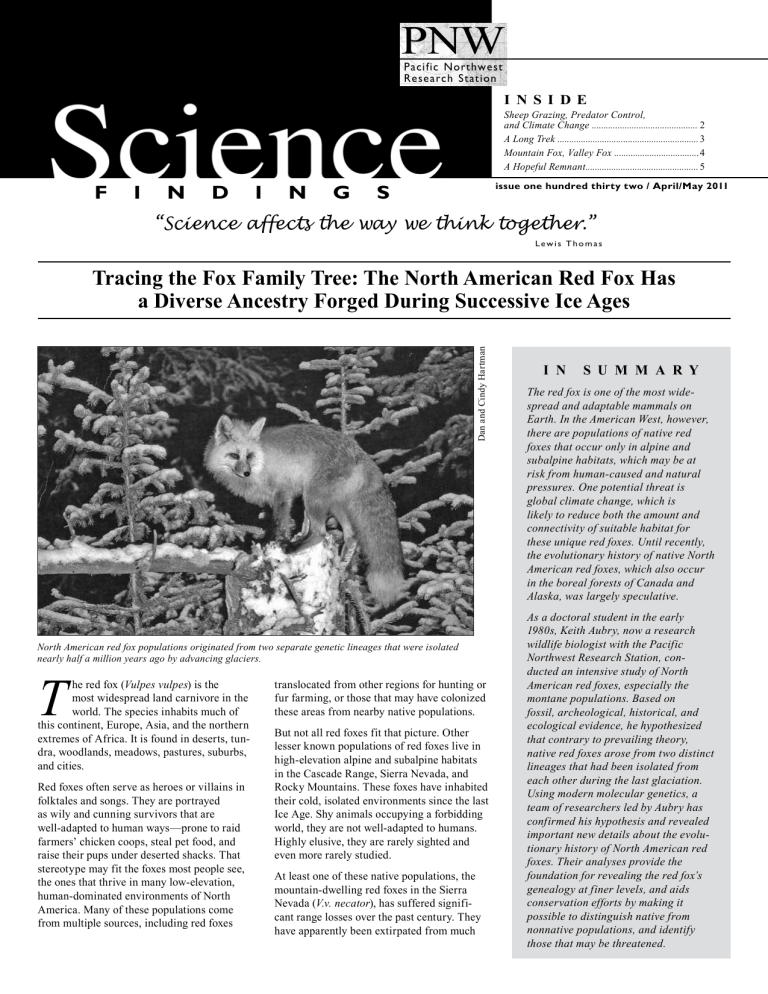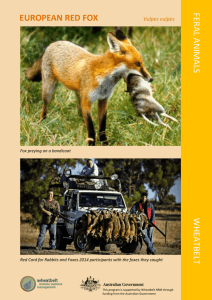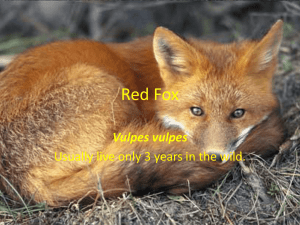PNW

PNW
Pacific Northwest
Research Station
I n s I d e
Sheep Grazing, Predator Control, and Climate Change ............................................. 2
A Long Trek ............................................................
3
Mountain Fox, Valley Fox ...................................
. 4
A Hopeful Remnant................................................ 5 issue one hundred thirty two / April/May 2011 F I N D I N G S
“Science affects the way we think together.”
L e w i s T h o m a s
Tracing the Fox Family Tree: The north American Red Fox Has a diverse Ancestry Forged during successive Ice Ages
North American red fox populations originated from two separate genetic lineages that were isolated nearly half a million years ago by advancing glaciers.
T he red fox ( most widespread land carnivore in the world. The species inhabits much of this continent, Europe, Asia, and the northern extremes of Africa. It is found in deserts, tundra, woodlands, meadows, pastures, suburbs, and cities.
Vulpes vulpes ) is the
Red foxes often serve as heroes or villains in folktales and songs. They are portrayed as wily and cunning survivors that are well-adapted to human ways—prone to raid farmers’ chicken coops, steal pet food, and raise their pups under deserted shacks. That stereotype may fit the foxes most people see, the ones that thrive in many low-elevation, human-dominated environments of North
America. Many of these populations come from multiple sources, including red foxes translocated from other regions for hunting or fur farming, or those that may have colonized these areas from nearby native populations.
But not all red foxes fit that picture. Other lesser known populations of red foxes live in high-elevation alpine and subalpine habitats in the Cascade Range, Sierra Nevada, and
Rocky Mountains. These foxes have inhabited their cold, isolated environments since the last
Ice Age. Shy animals occupying a forbidding world, they are not well-adapted to humans.
Highly elusive, they are rarely sighted and even more rarely studied.
At least one of these native populations, the mountain-dwelling red foxes in the Sierra
Nevada ( V.v. necator ), has suffered significant range losses over the past century. They have apparently been extirpated from much
I n s U M M A R Y
The red fox is one of the most widespread and adaptable mammals on
Earth. In the American West, however, there are populations of native red foxes that occur only in alpine and subalpine habitats, which may be at risk from human-caused and natural pressures. One potential threat is global climate change, which is likely to reduce both the amount and connectivity of suitable habitat for these unique red foxes. Until recently, the evolutionary history of native North
American red foxes, which also occur in the boreal forests of Canada and
Alaska, was largely speculative.
As a doctoral student in the early
1980s, Keith Aubry, now a research wildlife biologist with the Pacific
Northwest Research Station, conducted an intensive study of North
American red foxes, especially the montane populations. Based on fossil, archeological, historical, and ecological evidence, he hypothesized that contrary to prevailing theory, native red foxes arose from two distinct lineages that had been isolated from each other during the last glaciation.
Using modern molecular genetics, a team of researchers led by Aubry has confirmed his hypothesis and revealed important new details about the evolutionary history of North American red foxes. Their analyses provide the foundation for revealing the red fox’s genealogy at finer levels, and aids conservation efforts by making it possible to distinguish native from nonnative populations, and identify those that may be threatened.
of their historical range, which once extended from the southern Cascades down to Mount
Whitney in the southern Sierras.
Montane red foxes may be threatened in other portions of their historical range, but no one knows for sure, says Keith Aubry, because there’s a critical lack of reliable information on their current distribution and conservation status. Aubry is a Forest Service research wildlife biologist who has studied red foxes and other high-elevation carnivores for more than 30 years. “Those knowledge gaps are the biggest cause for concern right now,” says
Aubry. “If a biologist or manager asked me about the conservation status of montane red foxes in most parts of their range, I could only say that we simply don’t know.”
I
SHEEP GRAZING, PREDATOR CONTROL, AND CLIMATE CHANGE
n high mountain meadows, sheep ranchers once routinely killed coyotes and other predators by lacing dead sheep with poison; red foxes were probably among the victims. Historical overgrazing may also have depleted food for mice and pocket gophers, the foxes’ primary prey. Trappers took Sierra
Nevada red foxes for their pelts in the early days, but the trapping of red foxes has been prohibited in California since 1974. Today,
Purpose of PNW Science Findings
these montane red foxes may be threatened by diseases spread by domestic dogs (including rabies and canine distemper), run-ins with cars, and by a warming climate.
Mountain-dwelling red foxes live on isolated islands of cold, high country—shrunken remnants of habitat from the last Ice Age.
If the Earth continues to warm, these islands will shrink even further. Aubry’s colleague
John Perrine of California Polytechnic State
University reported that by 2100, high- elevation habitat in the Sierra Nevada could be reduced by half or more.
In 2009 Aubry, Perrine, and three other researchers (Mark Statham and Samantha
Wisely of Kansas State University and
Benjamin Sacks of the University of
California at Davis) published a breakthrough genetic analysis that revealed important details about the North American red fox’s ancient family tree. By analyzing DNA from
285 museum specimens, Aubry and his team showed that the red fox lineage had split into two major family groups much earlier than previously believed.
To provide scientific information to people who make and influence decisions about managing land.
K e Y F I n d I n G s
PNW Science Findings is published monthly by:
Pacific Northwest Research Station
USDA Forest Service
P.O. Box 3890
Portland, Oregon 97208
Send new subscriptions and change of address information to:
pnw_pnwpubs@fs.fed.us
• Researchers used genetic analyses to reveal the evolutionary history of the North
American red fox ( Vulpes vulpes ). Their work confirms that native populations originated from two separate lineages that were isolated nearly half a million years ago by advancing glaciers.
Rhonda Mazza, editor; rmazza@fs.fed.us
Cheryl Jennings, layout; cjennings@fs.fed.us
• The team’s genetic analyses provide the basis for further work to clarify genetic relationships among native subspecies and between native and introduced populations of red foxes. It also provides the scientific basis for investigating potential genetic linkages to their unique ecological adaptations.
science Findings is online at: http://www.
fs.fed.us/pnw/publications/scifi.shtml
• Red foxes in the Sacramento Valley are a distinct and previously undescribed native subspecies that is closely related to the Sierra Nevada red fox ( Vulpes vulpes necator ).
The research team has named the Sacramento Valley red fox Vulpes vulpes patwin.
United States
Department of Agriculture
Forest
Service
2
A LONG TREK
M any mammals colonized North America from Asia by crossing a land bridge that emerged near the Bering Strait as the sea level declined during each Ice Age. This northern icefree refugium, which included parts of Siberia, Alaska, and the Yukon, is known to paleontologists as Beringia. The red fox first reached North
America during the Illinoian glaciation (300,000 to 130,000 years ago).
Then, during the Sangamon interglacial period (130,000 to 100,000 years ago), red foxes expanded their range southward into what is now the contiguous United States.
When Aubry was a graduate student, the prevailing theory for the modern origin of red foxes in North America was that all were descended from animals that had been isolated south of the ice sheets (i.e., in the southern ice-free refugium, which included most of the contiguous
United States) during the most recent Ice Age—the Wisconsin glaciation (100,000 to 10,000 years ago). Then, when the glaciers finally retreated, red foxes followed their cold-climate habitat upward in elevation or northward in latitude, colonizing the montane and boreal habitats they occupied when European settlers first came to this continent.
That was the theory. But fossils of the red fox discovered during the 1970s in the northern refugium and the size of red foxes in
Washington’s Cascade Range when compared to those in western
Canada didn’t fit. Modern-day Cascade fox skulls are much smaller than those of the Canadian foxes even though their ranges are adjacent.
This was a puzzling anomaly. If both of these subspecies had originated from a single northward migration after the Wisconsin glaciers retreated, Aubry reasoned, their modern-day skulls should be closer in size.
“You would expect to see some differences among subspecies due to isolation and local adaptations,” he says, “but if they all originated from a single lineage that had expanded its distribution in a wave across the continent, you’d expect to see a more or less continuous gradient in size—a cline, as occurs among the northern red foxes from Alaska southeastward across Canada. Instead, there was an abrupt discontinuity in size between these adjacent populations, suggesting that the montane red foxes had evolved in isolation from the northern populations.”
This series of maps shows how the advance and retreat of glaciers over the past 300,000 years influenced the evolutionary development and dispersal of the red fox throughout North America.
His flash of insight convinced Aubry that the existing theory was wrong. Aubry dug into archeological and historical records and the ecological literature. When he put it all together, he concluded that
North American red foxes were derived from two distinct lineages (also known as clades) that had diverged from each other while they were isolated in both northern and southern refugia during the last glaciation.
Aubry further hypothesized that the montane red foxes were unique, both in size and habitat affinities, because they were the direct descendants of red foxes that had occupied the southern refugium during the last glaciation, whereas the red foxes in British Columbia were derived from a wave of post-glacial migrations that originated in the northern refugium and spread southeastward across western Canada.
3
It was an elegant hypothesis, supported by considerable natural history data. But it was unprovable until the advent of modern molecular genetics.
Now, that long-ago Eureka moment has been confirmed by genetic tests. Just as Aubry hypothesized, the main evolutionary stem forked into two major genetic lineages. “I knew my hypothesis was strong,” Aubry says,
“and our genetic analyses confirmed it in almost every detail. That was very gratifying.”
There was one surprise, however. Aubry had assumed that both the southern- and the northern-refugial red foxes were descendants of the original colonization event that occurred during the Illinoian glaciation. The genetic data clearly showed, however, that the northern refugial red foxes were not part of the original colonization of North America, but were derived from a second colonization event that occurred during the Wisconsin glaciation. That meant that the two North American lineages had split from each other almost half a million years ago, much further back in time than Aubry had suspected.
The team was also able to sketch in some of the finer details. At the height of the last Ice
Age, red fox populations that had been isolated in the southern refugium (the Widespread subclade) had, in turn, become isolated in western and eastern portions of the refugium.
Pollen-core data provide only a sketchy glimpse of the mid-continental landscape at that time, says Aubry, but at the height of the
Wisconsin glaciation, the Great Plains was a treeless, windswept desert—an extreme environment that was probably uninhabitable by red foxes and other boreal species.
When the Wisconsin glaciers melted, the foxes’ cold-climate habitat shifted to higher elevations and more northerly latitudes. Red foxes in the West (the Mountain subclade) colonized the alpine meadows and subalpine parklands in the high mountains, whereas those in the Eastern subclade followed boreal forests northward and colonized eastern and central Canada. At the same time, the northern or Holarctic clade foxes expanded their range southward across western Canada, meeting up with the eastern foxes in central
Canada.
I
MOUNTAIN FOX, VALLEY FOX
n a followup study, Aubry and his colleagues investigated the evolutionary origins of the Sacramento Valley red fox, a lowland inhabitant. Because these foxes did not live in the mountains, many biologists assumed they were another group of the mixed-breed foxes that are widespread throughout the California valleys. They’d been present since at least the late 1800s, but no one knew for sure whether they were native or introduced.
Through DNA analysis, the team, this time led by Ben Sacks, discovered that Sacramento
Valley foxes are not only native—they are closely related to the Sierra Nevada population—but represent a new subspecies of red fox. The team named it Vulpes vulpes patwin , after a Native American group that once inhabited the valley.
This finding highlights the practical promise of this sort of research. If managers can positively identify red foxes as native or nonnative, they can target conservation efforts to the appropriate gene pools. And, as they learn more about the influence of genes on environmental adaptations, they will have a basis for identifying the key ecological factors that limit survival in a given population.
For example, the research sheds light on a question long pondered by Aubry: Why don’t mountain and lowland foxes interbreed? In his doctoral work on Cascade red foxes in the 1980s, he’d observed that thick west-side forests and sparse east-side sagebrush deserts seemed to act as barriers to up- or downhill migration. Later, Perrine noted that there had been fur farms within the range of the Sierra
Nevada foxes, and escapees could easily have
In 2010, a remote-camera survey captured this image of a fox on the Humboldt-Toiyabe National Forest,
California.
joined the native foxes, but the genetic analysis found no mixing. in ways that the lowland, mixed-breed foxes are not. If so, some of these adaptations may be detectable through genetic analysis.
Similarly, says Aubry, lowland fox populations on the Olympic Peninsula—all introduced since European settlement—have not colonized the high Olympics, where native red foxes do not occur. “There are no obvious barriers to colonization—in fact, there’s a paved road right up to the alpine zone on the north side of the peninsula,” he says. “If introduced red foxes were capable of colonizing those high-elevation areas, they’d have gotten up there.”
The mountain-dwelling foxes, he surmises, must be adapted to their harsh environments
For example, Sacks’s team in their study of the Sacramento Valley red fox population speculated that the mountain foxes’ cold tolerance may be keyed to certain patterns in their mitochondrial DNA. Mitochondria—energygenerating bodies within the cells of most organisms—are known to be involved in metabolism. If such environmental preferences can be teased out of a fox’s genes, further research could yield insights into important ecological relationships, including the critical thresholds that limit survival.
4
A HOPEFUL REMNANT
U ntil the last few decades, the most recent physical evidence of red foxes in the high Sierras was a museum specimen collected in 1941. Accordingly, the
Sierra Nevada red fox was listed as a threatened species in California in 1980. However, during the winter of 1990–91, a photograph of a red fox was taken near Tioga Pass, just outside Yosemite National Park, raising scientists’ hopes.
In the intervening decades, biologists have used remotely triggered cameras, live traps, and other techniques to survey for red foxes and other high-elevation mammals throughout the Sierra Nevada. John Perrine had conducted a field study of the red foxes near Lassen
Peak during the late 1990s and early 2000s, but none had been found anywhere south of there—the Tioga Pass photo remained the last documented record from the southern Sierras.
Scientists feared the southerly foxes might be gone forever.
Then in August of 2010, Forest Service biologists Adam Rich and Sherri Lisius were conducting remote-camera surveys in the
Humboldt-Toiyabe National Forest, baiting their cameras with chicken parts stuffed into a sock. One of their cameras snapped a picture of a red fox as it jumped to grab the food.
Later in the fall, two more red foxes were photographed on the Stanislaus National
Forest a few miles away.
Wildlife biologists throughout California were buzzing: maybe the southern Sierra Nevada red foxes weren’t completely gone after all.
Ben Sacks was elated when the bait sock was recovered with fox saliva on it. Sacks and
L A n d M A n A G e M e n T I M P L I C A T I O n s
• Montane red foxes have suffered range losses during the past century from unknown causes. Global climate change poses a potentially serious threat to their persistence in the habitat islands they occupy in the high mountains. Genetic research provides the means for determining the current distribution and abundance of native montane foxes and for evaluating their conservation needs more effectively.
• The current study provides the foundation for further research on the genetic characteristics of North American red fox populations. This unfolding information will be essential for identifying potentially threatened native populations and will help managers understand the habitat factors that may be critical for their survival.
• The most urgent needs for the management and conservation of Sierra Nevada red foxes and other potentially imperiled populations are new field and laboratory studies designed to provide baseline information on their distribution and status, physiology, population dynamics, and habitat relations.
Researchers extracted DNA from saliva left behind on the bait sock (tied around tree) and determined that Sierra Nevada red foxes still lived in the area.
Mark Statham (now at U.C. Davis) extracted
DNA from the saliva and confirmed that the genetic signature matched that of the historical Sierra Nevada red foxes.
These detections have given scientists hope, but they also illustrate just how precarious the foxes’ situation is. Montane foxes are unique,
Aubry says, not only in their genetic makeup, but in their adaptation to a cold, isolated, and shrinking environment. “Native red foxes are an essential component of those montane ecosystems,” he says, “and to lose them would be to lose an important piece of the system. I hope our work makes people aware of these unique animals and of the disjunct and precarious nature of their primary habitat. They have been evolving in North America for hundreds of thousands of years, and are a unique form of the red fox that occurs nowhere else in the world.”
FOR FURTHER READING
Aubry, K.B.; Statham, M.J.; Sacks, B.N.;
Perrine, J.D.; Wisely, S.M. 2009.
Phylogeography of the North American red fox: vicariance in Pleistocene forest refugia. Molecular Ecology. 18: 2668–2686.
Perrine, J.D.; Campbell, L.A.; Green, G.A.
2010. Sierra Nevada red fox ( Vulpes vulpes necator ): a conservation assessment; final report R5-FR-010. U.S. Department of
Agriculture, Forest Service. 42 p. http://nrm.dfg.ca.gov/FileHandler.
ashx?DocumentID=23994.
(March 10, 2011).
Sacks, B.N.; Moore, M.; Statham, M.J.;
Wittmer, H.U. 2011. A restricted hybrid zone between native and introduced red fox ( Vulpes vulpes ) populations suggests reproductive barriers and competitive exclusion. Molecular Ecology. 20: 326–341.
Sacks, B.N.; Statham, M.J.; Perrine, J.D.;
Wisely, S.M.; Aubry, K.B. 2010. North
American montane red foxes: expansion, fragmentation, and the origin of the
Sacramento Valley red fox. Conservation
Genetics. 11: 1523–1539.
Sacks, B.N.; Wittmer, H.U.; Statham, M.J.
2010. The native Sacramento Valley red fox. Report to the California Department of Fish and Game, May 30, 2010. 49 p.
W R I T E R ’ S P R O F I L E
Gail Wells is a science writer based in
Corvallis, Oregon. She is the author of The
Tillamook: A Created Forest Comes of Age
(2 nd ed. 2004) and coauthor of Lewis and
Clark Meet Oregon’s Forests: Lessons From
Dynamic Nature (2004).
5
PRSRT STD
US POSTAGE
PAID
PORTLAND OR
PERMIT N0 G-40
F I N D I N G S
U.S. Department of Agriculture
Pacific Northwest Research Station
333 SW First Avenue
P.O. Box 3890
Portland, OR 97208-3890
Official Business
Penalty for Private Use, $300 s C I e n T I s T P R O F I L e
KEITH AUBRY is a research wildlife biologist with the USDA Forest
Service, Pacific Northwest Research Station in
Olympia, Washington. He has been studying the ecology of terrestrial wildlife in the Pacific Northwest for more than 25 years. Recent and current research activities include field studies of the pileated woodpecker, fisher, Canada lynx, and wolverine in the Pacific Northwest; the historical zoogeography and genetic affinities of the fisher, wolverine, and red fox in North
America; and the application of genetic information to wildlife research and conservation.
Aubry may be contacted at:
USDA Forest Service
Pacific Northwest Research Station
Forestry Sciences Laboratory
3625 93 rd Ave. SW
Olympia, WA 98512
(360) 753-7685
E-mail: kaubry@fs.fed.us
C O O P e R A T O R s
John D. Perrine, California Polytechnic State
University
Benjamin N. Sacks, University of California at Davis
Mark J. Statham, University of California at
Davis
Samantha M. Wisely, Kansas State University
The U.S. Department of Agriculture (USDA) prohibits discrimination in all its programs and activities on the basis of race, color, national origin, age, disability, and where applicable, sex, marital status, familial status, parental status, religion, sexual orientation, genetic information, political beliefs, reprisal, or because all or part of an individual’s income is derived from any public assistance program. (Not all prohibited bases apply to all programs.) Persons with disabilities who require alternative means for communication of program information (Braille, large print, audiotape, etc.) should contact USDA’s TARGET Center at (202) 720-2600 (voice and TDD). To file a complaint of discrimination, write USDA, Director, Office of Civil Rights, 1400
Independence Avenue, SW, Washington, DC 20250-9410 or call (800) 795-3272 (voice) or (202) 720-6382 (TDD). USDA is an equal opportunity provider and employer.







